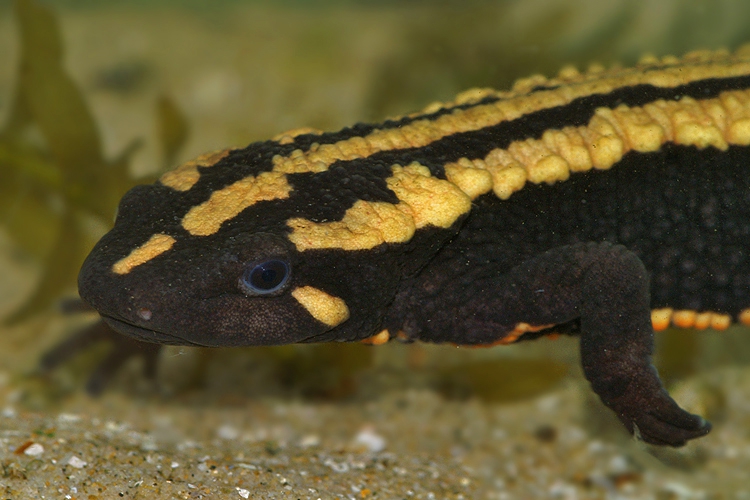| Citation |
IUCN SSC Amphibian Specialist Group 2014. Laotriton laoensis. The IUCN Red List of Threatened Species 2014: e.T59461A47152908. http://dx.doi.org/10.2305/IUCN.UK.2014-1.RLTS.T59461A47152908.en. Downloaded on 07 May 2019. |
Description |
Geographic Range
NATIVE
Extant (resident)
Lao Peoples Democratic Republic
NUMBER OF LOCATIONS
1
UPPER ELEVATION LIMIT
1,430 metres
LOWER ELEVATION LIMIT
1,160 metres
UPPER DEPTH LIMIT
LOWER DEPTH LIMIT
Geographic Range in detail
Population
CURRENT POPULATION TREND
Decreasing
NUMBER OF MATURE INDIVIDUALS
POPULATION SEVERELY FRAGMENTED
No
CONTINUING DECLINE OF MATURE INDIVIDUALS
Yes
Population in detail
EXTREME FLUCTUATIONS
NO. OF SUBPOPULATIONS
CONTINUING DECLINE IN SUBPOPULATIONS
EXTREME FLUCTUATIONS IN SUBPOPULATIONS
ALL INDIVIDUALS IN ONE SUBPOPULATION
NO. OF INDIVIDUALS IN LARGEST SUBPOPULATION
DESCRIPTION
The species appears locally abundant, with 1,200 individuals estimated to occur in 4.7 km of stream in an area thought to have the highest abundance of the species (Phimmachak et al. 2012). The species is likely to occur in relatively isolated sub-populations, as it only occurs in pools at the headwaters of streams. As they are mostly aquatic (but see evidence of overland dispersal by adults in Phimmachak et al. 2012) and restricted to high elevations, there is unlikely to be significant gene flow between sub-populations. Due to harvesting, and the loss and degradation of habitat it is estimated that there has been at least a 50% decline in population of the species in the last 10 years (S. Phimmachak and B. L. Stuart pers. comm.).
Habitat and Ecology
SYSTEM
Terrestrial, Freshwater (=Inland waters)
HABITAT TYPE
Forest, Artificial/Terrestrial, Shrubland, Wetlands (inland), Grassland
GENERATION LENGTH (YEARS)
CONGREGATORY
MOVEMENT PATTERNS
CONTINUING DECLINE IN AREA, EXTENT AND/OR QUALITY OF HABITAT
Yes
Habitat and Ecology in detail
Threats
Agriculture & aquaculture
Annual & perennial non-timber crops
Transportation & service corridors
Roads & railroads
Biological resource use
Hunting & trapping terrestrial animals
Threats in detail
THREATS
Its initial description (as Paramesotriton laoensis) in 2002 (Stuart and Papenfuss 2002) inadvertently brought the species and its localities to the attention of commercial traders, leading to ongoing unsustainable harvest and subsequent use in the international pet trade in Germany and Japan and, to a lesser extent, in traditional medicines (Stuart et al. 2006). Thus the primary threat to this species is over-harvesting, to which its biology (behaviour and morphology) makes it extremely vulnerable. As it is active during the day, swimming on the bottom of shallow pools in clear water (Stuart and Papenfuss 2002, Phimmachak et al. 2012), and is brightly coloured dorsally, it is harvested quickly, easily, and in large numbers. It is possible that all mature individuals could be harvested from a site in a few days, and this is why they are sold sometimes as "hundreds" of individuals or by the kilogram (S. Phimmachak & B. L. Stuart pers. comm. October 2013). New roads being constructed within the known range of the species also facilitate harvesting. Habitat loss and modification are also likely to threaten the species. Although the species is likely to be tolerant of some human modification of the surrounding habitat, it would probably suffer from severe changes in stream water quality or flow and extensive burning in grasslands adjacent to streams (where efts occur) (Phimmachak et al. 2012).
CLASSIFICATION SCHEME
Threats Timing Stresses Scope Severity Impact score Invasive species Virus
2. Agriculture & aquaculture 2.1. Annual & perennial non-timber crops 2.1.3. Agro-industry farming Ongoing
1. Ecosystem stresses 1.1. Ecosystem conversion
1.2. Ecosystem degradation
1.3. Indirect ecosystem effects
2. Species Stresses 2.2. Species disturbance
2.3. Indirect species effects 2.3.7. Reduced reproductive success
Unknown Unknown
4. Transportation & service corridors 4.1. Roads & railroads Ongoing
1. Ecosystem stresses 1.2. Ecosystem degradation
2. Species Stresses 2.2. Species disturbance
Unknown Unknown Unknown
5. Biological resource use 5.1. Hunting & trapping terrestrial animals 5.1.1. Intentional use (species is the target) Ongoing
2. Species Stresses 2.1. Species mortality
Causing/Could cause fluctuations Low Impact: 4
Use and Trade
Food - human
Local: ?National: ?International: ?
Medicine - human & veterinary
Local: ?National: ?International: ?
Pets/display animals, horticulture
Local: ?National: ?International: ?
Use and Trade in detail
USE AND TRADE
Laotriton laoensis is in high demand for the international pet trade and lesser demand for medicine and food (Phimmachak et al. 2012). Interviews conducted by Phimmachak et al. 2012 consistently reported that, historically, commerce in L. laoensis consisted of only limited local trade for medicinal or food purposes, but that demand for the species had dramatically increased in very recent years. For example, in April 2008, villages in Phoukout District, Xiengkhouang Province, reported selling 300–400 individuals of L. laoensis per year to visiting European or Japanese collectors for 5,000– 15,000 kip (US$0.60–$1.76) each. In June 2009, residents of Ban Chim in Phoukoun District, Luangphabang Province, reported selling a very large number ("hundreds") of L. laoensis in January 2009 to a visiting Chinese collector for 30,000 kip (US$3.53) per kg. Commercial networks have also become established in very recent years in response to demands for the species, and interviewees reported that Lao wildlife traders from Vientiane and Bolikhamxay provinces also had been placing orders with them to collect it (Phimmachak et al. 2012). There is also evidence that the demand for the species for medicinal purposes has increased, as interviews in May 2013 reported a Vietnamese trader with hundreds of dry L. laoensis in Xaysomboun district in 2011 (Wildlife Conservation Society Laos, unpubl. data). |

